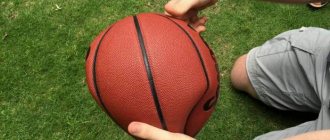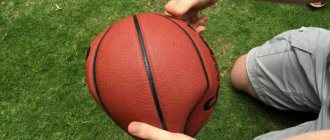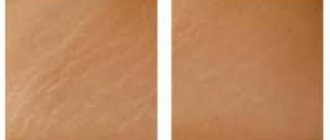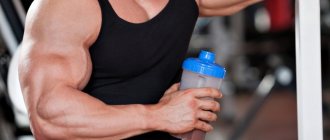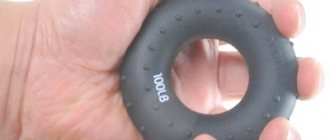Instructions for volleyballs
In order for a volleyball to serve you for as long as possible, it, like many other types of sports equipment, requires proper care and compliance with operating conditions.
These factors, as well as the intensity of use of the ball, largely determine its service life. The operating conditions of a volleyball mean, first of all, the type and properties of the playing surface and the weather conditions in which the ball is used, which in turn depends on the type of volleyball as a sports discipline. The basic types of volleyball are classic and beach volleyball.
Currently, classical volleyball traditionally uses glued balls made of synthetic and natural materials with the following technical parameters: ball weight 260-280 grams, circumference 65-67 cm. The ball’s compliance with these parameters is often reflected on the ball itself in the form of Official size & weight , Official parameters, Official Standard, FIVB official standard , etc. Please note that this marking in no way means that the ball is official (registered in the regulations for specific competitions, tournaments, participates in sponsorship contracts or is the ball of any federation or sports association, etc.). The presence of such features is usually indicated by additional information on the ball. Sometimes the balls indicate specific parameters of the material from which the ball is made, for example: – Microfiber Composite – microfiber synthetic leather – the best and technically advanced leather, produced exclusively in Japan or South Korea; – Composite Leather – composite, in other words modified, improved synthetic leather; – Genuine Leather – genuine leather, which at first may seem quite tough, but after games and training it becomes extremely soft, non-slip and pleasant to the touch; – Soft Touch is a term that translated from English means “soft touch”, and is used to mark balls that have high levels of “playing comfort” - the synthetic leather used to produce such balls is soft and elastic.
But when choosing a ball, you should be guided, first of all, by your own feelings and/or recommendations of professionals, and the inscriptions on the ball regarding the materials used should be taken as additional information.
Balls for classic volleyball can be not only glued, but also sewn, in which the panels of the ball are not glued to a chamber reinforced (wrapped) with thread, but the frame of the ball is sewn manually or using machines, and then a chamber is inserted into the frame/shell of the ball. However, volleyballs produced using hand- or machine-stitching technology belong to the category of amateur, very rarely training balls, because they have slightly different playing characteristics from glued balls, which do not meet the requirements of players with a higher level of training. All balls for official competitions are glued only.
Balls for classic volleyball are intended, first of all, for playing in halls with parquet or coating made of special synthetic materials; in rare cases, they can be used on specially equipped outdoor courts. Playing on hard (for example, cinder pitches) and very hard surfaces (asphalt) is extremely undesirable, because it significantly, by 2-3 times, reduces the life of the ball, and creates problems with returning the ball under warranty, since operating conditions are violated.
One of the stages of the technology for producing laminated (glued) volleyballs is gluing panels onto a reinforced (thread-wrapped to maintain shape) chamber of the ball. Therefore, to avoid peeling of the panels, it is not recommended to use laminated balls made of natural and synthetic leather in adverse weather conditions (rain, slush, high humidity and temperature). In addition, volleyballs are generally not intended to be played at temperatures below 0°C.
Beach volleyball balls are made by hand or machine stitching; for their production, they try to use wear-resistant and moisture-resistant types of synthetic leather. Such balls are practically not produced from genuine leather due to the excessive hygroscopicity (moisture absorption) of this material. Since the games are held outdoors, for better visibility of the ball and greater entertainment, the balls are made bright, contrasting, often with fancy designs. For international competitions held under the auspices of the FIVB (International Volleyball Federation), the ball must have a larger circumference than regular balls - 66-68 cm. Colored, bright, but glued balls should be classified as balls for playing classic volleyball. The marking of beach volleyball balls in terms of materials and parameters is the same as for classic ones. The word Beach is often included in the name of beach volleyball ball models, which means “beach” in English. “Beach” balls already in their name carry a recommendation for use: they should be played on specially equipped (primarily sandy) beach volleyball courts. The balls can also be used for playing on outdoor courts with soft synthetic surfaces. Playing on hard (for example, cinder pitches) and very hard surfaces (asphalt) is extremely undesirable, because it significantly, by 2-3 times, reduces the life of the ball, and creates problems with returning the ball under warranty, since operating conditions are violated. Beach volleyball balls can be used for playing in unfavorable weather conditions (rain, slush, high humidity and temperature), but care must be taken to ensure proper care of the ball! Beach volleyballs are not intended to be played in temperatures below 0°C.
How to inflate a ball without a pressure gauge?
In a situation where you have to inflate the ball in the field and there is no way to use a pressure gauge, lift the projectile to shoulder height and throw it down. If the ball bounces off the ground at about waist level, then you have pumped the ball correctly.
Interesting materials:
Where can I find my personal Inn? Where can I find the master silver sword of the cat school? Where can I find the Bear School Master Silver Sword? Where can I find the Sword of Lothric? Where can I find the Bear School Sword? Where to find a medical helicopter in GTA 5? Where can I find a lot of nirn root? Where can I find my audio recordings? Where can I find the modem settings on my computer? Where to find an oasis in ZP?
Method No. 1: compressor
How to inflate a ball without a needle? Contact any of the car services in your locality - employees will help you for free or for a nominal sum. Don’t ignore tire shops: they will definitely have powerful compressors for inflating car tires. One thing: there is a risk of pumping the product with air, which will lead to its damage or even explosion.
A compressor is equipment from which air comes out under pressure. Therefore, this is an excellent answer to the question: “How to inflate a ball without a needle and pump?” If possible, it is recommended to carry out the procedure together: one person will turn the compressor on and off, and the second will hold the ball and press the cord, controlling the process of air flow. The hose with the nozzle is pressed tightly against the valve, after which the device turns on at full power. It must be decontaminated immediately as soon as the surface of the ball becomes hard. That's all!
Let us also draw your attention to the fact that many models of automobile compressors have special nozzles for inflating balls with air.
Choosing the right ball
There are the following types of bouncing balls:
- classic bouncing ball (without various additional devices);
- a bouncing ball for children, it has special horns;
- bouncing ball with handles.
Each of the above types can have a smooth or textured coating.
Small children will be more pleased with balls with the image of some animal or, for example, a bouncy ball with horns. The advantages of the latter are that the horns amuse the child and are comfortable to hold on to while jumping.
For older children and adults, it is better to purchase a gymnastic fitball or jumping ball with a handle that is comfortable to hold on to while performing exercises. To prevent the handles from slipping out of your hands, their surface is made of non-slip materials.
The size of the jumper is chosen based on the age of the child:
- at 1-3 years old, a bouncing ball with horns 45 cm;
- at 4-6 years old - 50 cm;
- at 7-9 years old - 55 cm;
- at 10-12 years old - 60 cm;
- for children over 12 years old or adults - 65 cm.
Be sure to follow these recommendations, otherwise the benefits of the exercise will decrease.
One of the recognized leaders in the production of bouncing balls is the Torres company. Torres balls are high quality and made from durable PVC. Another advantage of this company’s products is safety for users: bouncy balls for children do not explode if punctured, but slowly deflate without scaring the child. The most common model is the Torres 55 cm bouncy ball with handles.
An equally interesting type of ball is the Mondo bouncing ball. It is suitable for both games and exercise. The ball is also made of high-quality PVC and equipped with a long plastic handle. To play with it, you need to stand with your feet on a special stand and jump while holding the handle.
other methods
Let us give you some more tips:
- If you do not find a medical syringe, then its needle can be replaced with an empty refill from a regular ballpoint pen.
- If you only managed to pump up the ball a little, then you can restore its hardness and elasticity like this: just keep it in hot water for a while. This will cause the air inside the product to heat up, causing it to expand, which will complement the jumping effect.
- Silicone grease for nipple treatment can be replaced with machine oil.
- The needle can be attached to the cap of a plastic bottle for a homemade pump with a glue gun.
- Instead of a compressor, bicycle pump, bag or bottle, you can use a regular rubber medical bulb.
- A can of compressed air, a car's spare tire, or a trash bag can also act as a pump.
So we have looked at all the available ways to pump up any ball with a valve with air if there is no pump and a special needle nearby. Go to a car repair shop, use a medical syringe, build your own tool - choose what is most suitable for you.
Popular ways to inflate a ball without a needle, and how to deflate it correctly
It's getting warmer outside, and it's time to remember spending active time with your children. Nothing diversifies leisure time better than sports games. In this case, many people wonder how to properly inflate a ball without a needle. Oddly enough, there are plenty of ways, the main thing is to know the technology and remember to be careful.
Popular methods
You don’t always have a special needle at hand with which you can inflate a football, basketball, children’s or beach ball. If this is the situation, then do not despair ahead of time. Users have come up with many simple methods that will be useful for both adults and children.
Compressor for car tires
If there is a car service or tire shop nearby, you should contact them. Employees of the car repair service system sometimes help people inflate balls absolutely free of charge. Such organizations have compressors designed for tires, but they are also suitable for the described sports equipment.
Compressors are very powerful, so you need to be as careful as possible so as not to overpump the product and cause it to rupture.
A pressing question for people not involved in auto repair is how to properly inflate a ball with a compressor? The procedure is simple, but it is advisable to carry it out with a partner. The task of the first is to control the device (turning it on and off), the second is to hold the ball or cord. You should proceed like this:
- Take a soccer ball and find the hole to inflate.
- Press the compressor hose against it.
- Turn on the device.
- Wait until the product is filled with air.
- Turn off the device.
It is important to turn off the compressor in time. Excessive inflation will damage the product. The person holding the sports equipment must control the air flow.
Modern compressors are equipped with special attachments for pumping balls.
Using electrical tape and a pump
The following method allows you to inflate a volleyball at home. To implement your plan, you will need a needle from a syringe. You also need a regular bicycle pump and electrical tape. Instructions on how to inflate a ball without a special needle at home in this way:
- Take a needle from a medical syringe or from a blood transfusion system and blunt its end. This is easy to do on any stone; you can also use a nail file. If this step is ignored, there is a risk that the tip will break the nipple, causing the ball to deteriorate. Needles from transfusion systems are the best option, as they are strong and inflexible.
- Wrap the needle with electrical tape. This will be a kind of adapter. For reliability, it is worth making at least 10 layers.
- Attach the device using electrical tape to the pump tip.
- Start pumping.
During pumping, you must constantly monitor the pressure gauge. Average values are 0.4–0.9 bar. Sometimes the recommended pressure is indicated on the ball. Some pumps are not equipped with a pressure gauge.
Volleyball rating
Among the manufacturers, there are several companies whose products are widely used by amateurs and professionals:
- Mikasa
. The Japanese company produces balls certified by the International Volleyball Federation. The assortment includes amateur and professional models, gaming and training. The Mikasa volleyball is of high quality and durability. - Gala
. The Czech company is the only European brand that produces balls for the major leagues. Compared to other manufacturers, Gala products have an affordable price. The materials used are microfiber and polyurethane. - Jogel
. The company specializes in the production of sports equipment for amateurs. The bladder of volleyballs is made of artificial rubber, which helps maintain stable internal pressure. - Torres
. The company produces the best volleyballs in the budget segment. They can be used both indoors and outdoors. Torres balls are purchased for educational institutions, amateur games and training.
History of the volleyball
The game appeared at the end of the 19th century. in the USA and quickly gained worldwide popularity due to the simplicity of the rules. The first volleyball was presented to the public in 1896 and was almost no different from a basketball. As the game became more and more popular, it became lighter and softer. The modern volleyball size and weight were first proposed at the Tokyo Olympics in 1964.
Since then, manufacturers have begun to produce many types designed for indoor or outdoor play. In 1996, the Japanese company Mikasa released a volleyball for beach sports. It withstood exposure to sunlight and was waterproof. Currently, the company's products are used at all Olympic Games.
What is the difference between a soccer ball and a volleyball?
In addition to the external similarities, there are significant differences between the two types of sports equipment. Here's how volleyballs differ from soccer balls:
- less weight and diameter;
- the volleyball ball is more elastic;
- since football is played with feet, the ball is stronger and can withstand significant load;
- volleyball panels have an oblong shape;
- The classic color of a soccer ball is black and white, a volleyball is yellow and blue.
Method number 2: electrical tape, syringe needle, bicycle pump
The tools here are some of the most accessible: a bicycle pump is available in almost every home, you can easily buy electrical tape at a department store or hypermarket, and a syringe at a pharmacy. How to inflate a ball without a needle using this method? As easy as pie:
- Take a syringe needle - the first thing you need to do is sharpen its sharp tip on asphalt, brick, stone, curb or a special knife. If it is too sharp, it will easily pierce the nipple, which will make the ball unusable. The best needle would be for blood transfusion systems - it is thick, durable, and does not bend.
- The second step is to make a kind of adapter from electrical tape - 10-12 layers of it are enough. They need to be wound tightly so that the air does not escape back when pumping.
- How to inflate a ball without a needle? Attach the invention to the bicycle pump and begin the procedure.
Method number 3: syringe
How to inflate a volleyball, basketball, soccer ball without a needle? Use a large medical syringe! This is a last resort, because the method is quite grueling - you will spend about 2 hours on the procedure.
As with the second method, you will need to blunt the needle, otherwise you will damage the nipple and the ball will continue to deflate. Which syringe to choose? The bigger, the better:
- It’s possible to pump up a ball with a twenty-cubic ball in 30-40 minutes.
- A ten-cc syringe will make you pore over the ball for an hour to two.
Before starting the procedure, we recommend that you treat the nipple with silicone grease - this will protect it from damage from an imperfect syringe needle. The procedure is simple: insert the needle into the hole, press the syringe lever, and release the air. Then remove the tool, return the lever to its original position and repeat the procedure.
Not all balls can be deflated
Modern ball manufacturing technologies dictate new rules: laminated (glued) products are stored and transported inflated. If you try to bleed air, the heat seal seams will crack. Adidas Telstar 18, Adidas Krasava, any official competition balls, and all basketballs require careful handling. And once again about the main thing: if necessary, replace the special needle with any dull hollow rod of a suitable size, press the valve and bleed the air. This should be done carefully so as not to damage the inner surface of the nipple, but it is better to still buy a needle and not risk deflating the ball if necessary.
Source
How to seal a soccer ball: rules and the best means for repair
People often wonder how to tape a soccer ball. To solve this problem, it is necessary to strictly follow the rules of the procedure. First of all, you need to find the puncture area. After which it is important to choose the right adhesive composition. Effective means include rubber glue or superglue.
To achieve reliable fixation, it is necessary to strictly follow the technology of the procedure.
How to Find a Puncture on a Soccer Ball
There are often situations when the ball does not hold air, but damage cannot be visually identified. To detect such areas, it is recommended to inflate the product and immerse it in water. Air bubbles will begin to emerge from the punctured area. It is worth considering that the product should be completely dry before starting repairs.
What will be needed for repairs
For the repair to be successful, you need to prepare everything you need in advance. For this purpose, adhesive composition and other tools are used.
Rubber glue
A rubber ball can be sealed with rubber glue. Gummi would be an excellent option. This product has an affordable price and has many positive reviews. The substance is quite simple to use.
To do this, apply a thin layer of glue to the hole and leave to dry. This will take 5-10 minutes. Then the procedure should be repeated. After the second layer has dried, the product can be inflated.
Super glue
Superglue is also highly effective. The substance can be applied with a knitting needle. Thanks to this, the composition will get onto the surface and into the hole.
A piece of rubber or a ready-made patch
To seal large damage, you can use a piece of rubber. Special patches are also available for sale. It is worth considering that self-adhesive materials are considered less durable.
Therefore, it is recommended to choose conventional products and apply the fixing composition yourself. Before the procedure, it is recommended to treat the damaged area with acetone. After this, glue must be applied to the ball and patch.
First you need to remove all excess from it and leave 2 centimeters around the puncture.
Sharp knife or scissors
These tools are required to cut patch pieces. It is important to use the sharpest possible tools.
Acetone
This substance is required to degrease the surface of the product and the patch. It is strictly forbidden to use gasoline or any solvents for this purpose.
How to repair
For the repair to be successful, it is recommended to wash the ball. This should be done with a mild remedy. Then dry the product in natural conditions. It is recommended to degrease the damaged area. To do this, you should use alcohol or acetone.
It is recommended to repair sports equipment depending on its type and the nature of the damage. A tubeless ball is easier to recover. However, there are also ways to repair the camera. It is recommended to glue the ball in a deflated state. A constant flow of air will cause the adhesive to fail to set.
If there is a small hole
The smaller the damaged area, the easier it is to repair the puncture. To repair a volleyball or soccer ball, you should follow these steps:
- Find a hole on the surface.
- Seal the hole with rubber cement.
- Wait the required period of time. In this case, you should follow the instructions given on the adhesive composition.
It is acceptable to repair the ball with superglue. To apply this substance, you should use a knitting needle. Thanks to this, the glue will get not only onto the surface of the product, but also into the hole.
Without cutting the surface
To seal the surface of the ball, you should use a special patch. Stores sell ready-made products - they are covered with glue. Such patches are convenient and easy to use. They can also be taken on the road.
To carry out repairs, do the following:
- Degrease the damaged area.
- Cut off all excess from the patch. This is done so that the product extends slightly beyond the hole.
- Remove the adhesive surface of the patch.
- Place the product on the ball.
It is also acceptable to use patches that do not have an adhesive layer. They include a layer of rubber and are used in combination with superglue. Also, to fix such patches, a rubber compound or a second agent is often used.
Sealant from the inside
Sometimes experts use sealant to repair the camera. It is used from inside the ball. To carry out the procedure, you will need a syringe without a needle. It is recommended to fill it with sealant. Then squeeze the substance into the damaged area of the camera. This method is used for minor damage. It does not require cutting the ball.
If the camera is torn
If the chamber is damaged, the ball must be cut in the area of the inflation hole. To repair the product, you should perform the following steps:
- Find the damaged area.
- Make a patch out of rubber. It should be slightly larger than the damaged area.
- Cover the patch with superglue.
- Press well and leave for 1-2 minutes.
- Deflate the ball and put the camera in place.
- Glue the chamber and casing.
- Sew up the incision area with nylon threads.
It is worth considering that the rope chamber is almost impossible to repair. In such a situation, the ball will have to be thrown away.
Method number 4: there is a needle, but no pump
We looked at how to inflate a ball without a needle (basketball, volleyball, football, etc.) But what if you have one (or you made a needle yourself), but don’t have a pump? We offer the following instructions:
- The pump will be replaced by a regular plastic carbonated drink bottle. As a last resort - a tight plastic bag without holes.
- Now you need to screw the needle into the cap of the container or solder it. This will be the adapter. Check that it is not leaking air.
- Then you need to lubricate the ball nipple with silicone grease.
- But now we need to pump air into our homemade pump with our hands (or, if it’s convenient for you, with our feet), from where it will flow into the ball through a needle.
Types of volleyballs
According to their purpose, all products can be divided into four groups:
- Classic volleyball for professional play
. Used at Olympics and competitions. It is made of durable quality materials, has a weight of 260 to 280 g and an internal pressure of 0.31 kg/cm². During production, the ball undergoes strict control and selection. The product must be light, elastic and have a predictable trajectory of movement upon impact. - Amateur ball
. Compared to professional ones, it has a lower price. There are no strict requirements for it, so deviations from the classical parameters are allowed during production. - Beach volleyball ball
. It differs from other types in that synthetic materials are used in production. The ball does not deform or become heavier after hitting the water. The 21.5 cm diameter provides good wind resistance, which is important when playing outdoors. - Training ball
. Used by athletes to practice punches. The ball weighs more than other models and is less elastic.
In addition to their purpose, all products can be divided into two types according to the production method:
- Sewn
. They are made from genuine leather, but there are also synthetic options. The production technology allows us to make inexpensive balls that are resistant to moisture and temperature changes. - Glued
. More expensive and difficult to manufacture. They have better wear resistance, but are afraid of moisture and high temperature. Used by professional athletes for indoor play.
How to act
There are three important conditions that we need to be aware of when deflating the ball if we plan to train with it for more than one season.
- Lubricate the hole, needle, or whatever you replaced it with with oil. Regular petroleum jelly or glycerin will also work. This will make the process easier and protect the valve from damage, drying out, and cracking. True, when there is no special needle at hand, most likely there is no oil. In this case, moisten the instrument with at least saliva.
- Insert the improvised needle into the nipple strictly perpendicular to the surface - this way the danger of ruining it is minimal.
- Do not “sway” the needle inside the adapter; maintain the original position until the end of the event (again, we take care of the integrity of the nipple).
How to make a ball out of socks?
You can make a soft ball out of old socks. Cut off part of the sock, add peas or some cereal there and sew it up - you’ll get an excellent soft ball for a child. It’s nice to hold it in your hands and you don’t mind losing it somewhere – you can make more, dad has a pile of socks!
Interesting materials:
How to properly level a concrete wall? How to properly dry a down jacket? How to properly seal windows for the winter? How to properly freeze honey mushrooms for the winter? How to properly freeze boletus mushrooms? How to properly certify a copy of a work book 2022? How to make a tone call correctly? How to prevent dust? How did they come up with the Joker? How to prepare hydrangea for wintering?
Care and storage instructions
1. After each game, wipe the ball with a damp cloth. In case of heavy soiling, use a cloth soaked in warm soapy water; under no circumstances use abrasive cleaners, or products containing solvents or other aggressive substances. 2. Let the ball dry naturally; if the ball is very wet, then wipe it dry with a soft cloth first. Dry the balls in a well-ventilated place, away from heat sources, at a temperature of +20-25°C and a humidity of 60-65%. Avoid exposure to direct sunlight and never dry the ball near or on the surface of heating devices. Prolonged exposure to dirt, moisture, and elevated temperatures lead to a deterioration in the physical properties of the ball, and, as a consequence, its playing characteristics, and a reduction in service life. 3. It is recommended to store balls in a dry, ventilated place at a temperature from +5°C to +25°C and a relative humidity of 50-80%. Balls must be protected from direct sunlight, exposure to vapors, gases and chemicals. 4. Laminated (glued) balls should be stored and transported in an inflated state. Otherwise, the tire material may become deformed and the panels may peel off. Following the above simple rules will allow you to preserve the life of your ball for a long time and avoid difficulties when returning a product under warranty not because of a manufacturing defect, but because of a violation of operating conditions!
We wish you a wonderful game and amazing victories!
How to fill a balloon with air
When purchasing, choose one that is appropriate for your height, the best way to check is to sit on a tight gymnastic ball, your thigh should be parallel to the floor, and a right angle should form between the thigh and shin.
It is more convenient to transport the ball deflated. When you come home or to the gym, follow the following instructions:
- first you need to stop the ball from swinging on the floor when it is inflated, to do this, place the ball against the wall, and place a box or stool at a distance of its diameter;
- the pump should have a cone-shaped tip, often pumps have many nozzles, and the cone nozzle is suitable for both inflatable toys and a gymnastic ball; to inflate some types of this gymnastic equipment you need a needle that is suitable for soccer balls;
- there should be a lid for the nipple nearby, which will need to be used to close the inflated ball; if the lid (plug) is already in place, it needs to be pryed off with a spoon or knife;
- sometimes there is a special plastic pad that determines the fullness of the inflated ball; if the ball is deflated, it should fit freely on the ball;
- inflate, determine whether the ball is fully inflated by the stool, which should have been set at a distance equal to the diameter of the ball, or by the fact that the plastic dimensional pad (plastic or in the form of string) will be fully stretched;
- the pump must be quickly removed and the hole in the ball closed with a lid;
- In order to properly inflate and prevent the ball from bursting, buy a gymnastic apparatus with a special valve, which helps to avoid an explosion when the rubber shell ruptures.
How many atmospheres should the balls be inflated to?
Many people determine how much to inflate the ball empirically, but it is better to follow the manufacturer’s recommendations. This information is usually located near the nipple and is indicated in the Bar indicators. The average values for how many atmospheres to inflate balls are as follows:
- for playing on hard surfaces up to 0.8 bar;
- in the gym - about 0.6 bar;
- on unsteady ground or lawn – 0.6-0.8 bar.
This applies to football, basketball and volleyball, but a gymnastics ball or a children's rubber ball requires less pressure - they are inflated by eye. Professional soccer balls used by teams on the field are pumped up to a pressure of 0.8-1 bar.
But how can you inflate a soccer ball at home if the pump does not have a pressure gauge showing pressure? A properly inflated product should be moderately hard and elastic. A loose structure is a sign of insufficient pressure.
What to choose: a strong blow or an accurate one?
4). What to choose: a strong blow or an accurate one?
Strong kicks are performed with the toe or different parts of the instep, since in these cases the kicking leg can move at a higher speed, and the area of contact of the leg with the ball is smaller than when striking with the inside of the foot.
Strikes delivered with a wide plane are more accurate. The highest accuracy is achieved when striking with the inside of the foot, somewhat less - when striking with the instep (its different parts), and the lowest - when striking with the toe.
We do not yet understand with the child which part of the foot produces this or that blow. Our task is to follow some principles, which will be discussed below.
